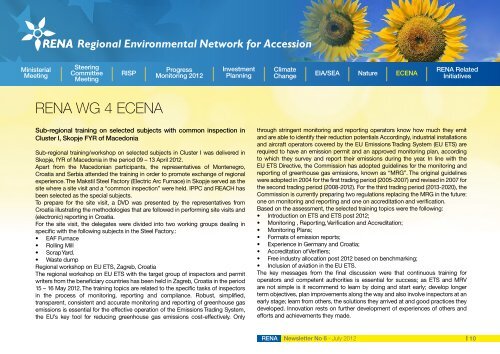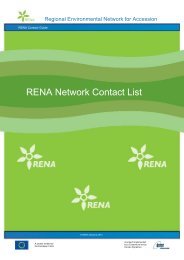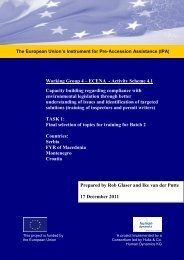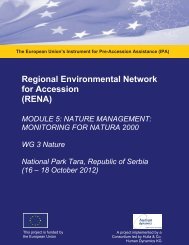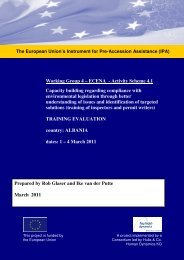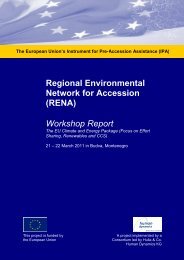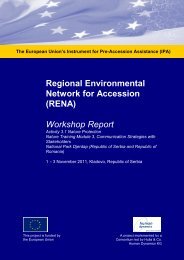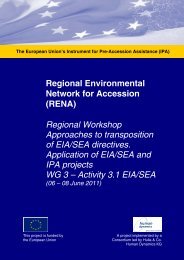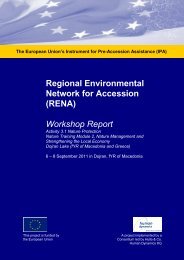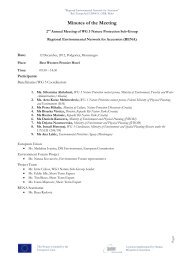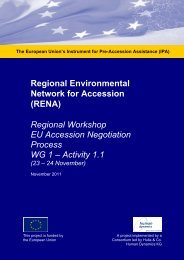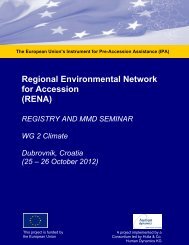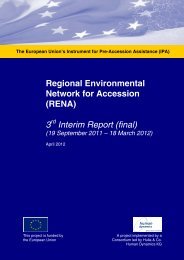RENA Newsletter 6_July.pdf - Renanetwork.org
RENA Newsletter 6_July.pdf - Renanetwork.org
RENA Newsletter 6_July.pdf - Renanetwork.org
You also want an ePaper? Increase the reach of your titles
YUMPU automatically turns print PDFs into web optimized ePapers that Google loves.
ECENA<strong>RENA</strong> WG 4 ECENASub-regional training on selected subjects with common inspection inCluster I, Skopje FYR of MacedoniaSub-regional training/workshop on selected subjects in Cluster I was delivered inSkopje, fYR of Macedonia in the period 09 – 13 April 2012.Apart from the Macedonian participants, the representatives of Montenegro,Croatia and Serbia attended the training in order to promote exchange of regionalexperience. The Makstil Steel Factory (Electric Arc Furnace) in Skopje served as thesite where a site visit and a “common inspection” were held. IPPC and REACH hasbeen selected as the special subjects.To prepare for the site visit, a DVD was presented by the representatives fromCroatia illustrating the methodologies that are followed in performing site visits and(electronic) reporting in Croatia.For the site visit, the delegates were divided into two working groups dealing inspecific with the following subjects in the Steel Factory.:• EAF Furnace• Rolling Mill• Scrap Yard.• Waste dumpRegional workshop on EU ETS, Zagreb, CroatiaThe regional workshop on EU ETS with the target group of inspectors and permitwriters from the beneficiary countries has been held in Zagreb, Croatia in the period15 – 16 May 2012. The training topics are related to the specific tasks of inspectorsin the process of monitoring, reporting and compliance. Robust, simplified,transparent, consistent and accurate monitoring and reporting of greenhouse gasemissions is essential for the effective operation of the Emissions Trading System,the EU’s key tool for reducing greenhouse gas emissions cost-effectively. Onlythrough stringent monitoring and reporting operators know how much they emitand are able to identify their reduction potentials Accordingly, industrial installationsand aircraft operators covered by the EU Emissions Trading System (EU ETS) arerequired to have an emission permit and an approved monitoring plan, accordingto which they survey and report their emissions during the year. In line with theEU ETS Directive, the Commission has adopted guidelines for the monitoring andreporting of greenhouse gas emissions, known as “MRG”. The original guidelineswere adopted in 2004 for the first trading period (2005-2007) and revised in 2007 forthe second trading period (2008-2012). For the third trading period (2013-2020), theCommission is currently preparing two regulations replacing the MRG in the future:one on monitoring and reporting and one on accreditation and verification.Based on the assessment, the selected training topics were the following:• Introduction on ETS and ETS post 2012;• Monitoring , Reporting, Verification and Accreditation;• Monitoring Plans;• Formats of emission reports;• Experience in Germany and Croatia;• Accreditation of Verifiers;• Free industry allocation post 2012 based on benchmarking;• Inclusion of aviation in the EU ETS.The key messages from the final discussion were that continuous training foroperators and competent authorities is essential for success; as ETS and MRVare not simple is it recommend to learn by doing and start early; develop longerterm objectives, plan improvements along the way and also involve inspectors at anearly stage; learn from others, the solutions they arrived at and good practices theydeveloped. Innovation rests on further development of experiences of others andefforts and achievements they made.<strong>RENA</strong> <strong>Newsletter</strong> No 6 - <strong>July</strong> 201210


